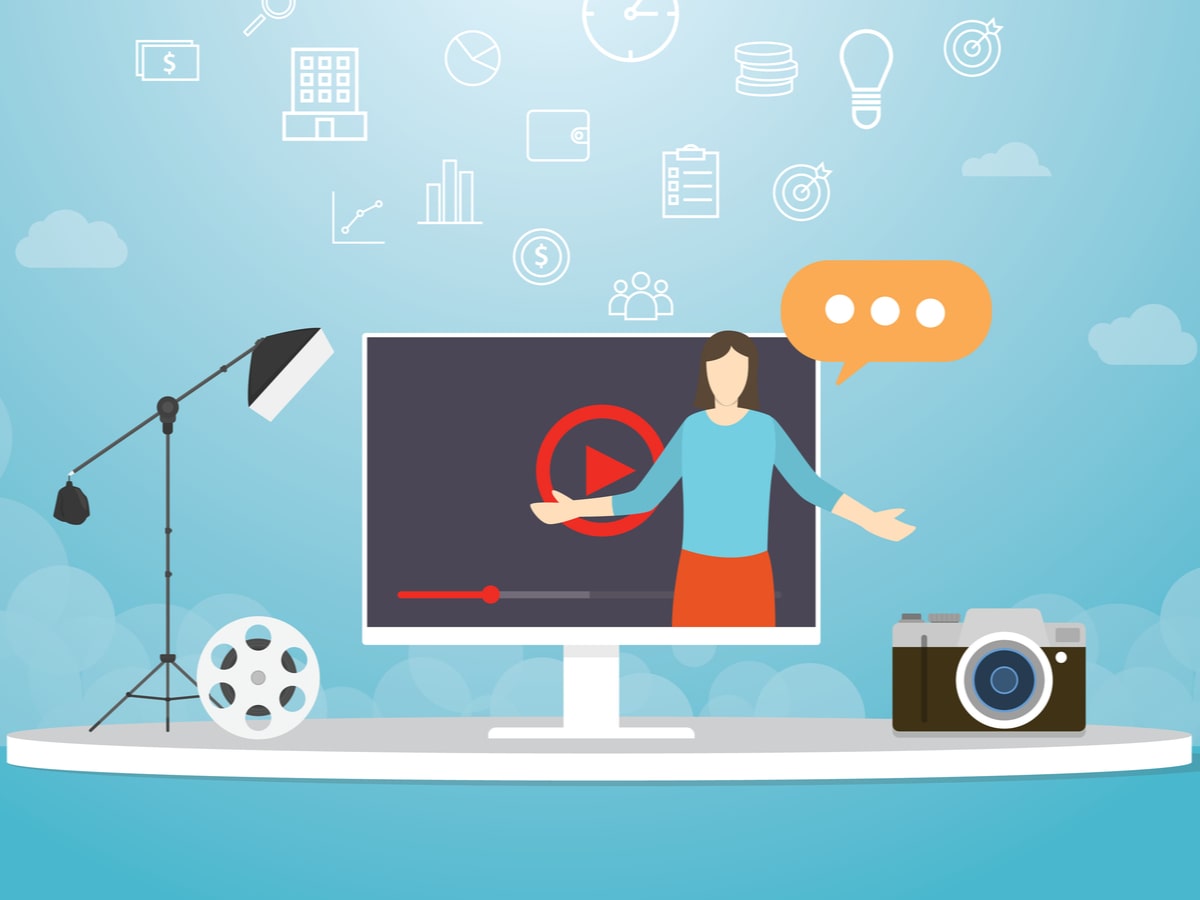Business animation is the art and science of video storytelling without using live actors. Also called business animation, it’s a powerful medium for explaining new ideas and increasing sales. Can animated explainer videos help you reach your own goals? That depends on whether you use corporate animation tools correctly. In this article, we’ll go behind the scenes to show you some useful new tricks from a leading corporate video production company.
But first, let’s do a quick overview of the industry.
What is corporate animation?
The corporate video production industry provides a wide range of animation services, mostly for B2B vendors. At one extreme, there are high-end medical animators who create stunning 3D effects to illustrate processes down to the cellular level. Such effects are impressive, but the 3D process is slow and expensive.
3D vs. 2D animation
On the other hand, most videos are made in 2D. It’s simpler and less expensive, although not quite as impressive.
To get a sense of state-of-the-art 2D animation at its best, check out this clip:
It’s the sort of high-converting video that holds viewers’ attention and convinces them to buy products and services.
Obviously, 3D rendering is a higher-niche service than 2D. But it takes longer, costs more, and gives you only an incremental improvement over “flat” animation.
For most B2B projects you won’t need much precision and attention to detail. You can generally use less-costly 2D animation to achieve your goals.
Here’s another example of a winning promo:
It explains the benefits of a housing program much more quickly and cheaply than a live representative could do. That’s how explainer videos save time and money.
Comparing 2D and 3D
To make sure you know the full range of options available for making business videos, let’s take a closer look at the strengths and weaknesses of both 2D and 3D animation.
If you’re wondering how commercial animation was first developed, here’s the story: 2D animation originated in the 19th-century with illustrated “flip-books” containing popular stories.
Each page held a colored image, so flipping through the pages quickly would produce a visual effect of movement to tell the story. Early folioscopes and stereoscopes worked in the same way – Moving discs with sequential images created a primitive form of animation.
By why does the human eye see movement in static images?
Retinal persistence and “cel animation
It’s worth taking a quick look at how the eye perceives sequential individual images as movement. If you’re wondering about the name for this illusion that creates a perception of movement, it’s called retinal persistence.
This same effect also occurs with old-time cartoon animation in which each “cel” was painted individually, showing the characters in stages of movement.
[image]
The same retinal persistence is also in effect when you’re watching modern animation. Of course, the difference is the speed of image renewal – Digital images can be updated thousands of times faster than old hand-painted cels.
Walt Disney was the pioneer of 2D commercial animators. Even though he’s known as the creator of Mickey Mouse, Donald Duck, and other beloved 2D animated characters, his true legacy for corporate video production was his use of organized storylines to tell a coherent and entertaining story.
Today’s corporate video producers still follow his method of using storyboards to sketch out the flow of ideas. But instead of filming fairy tales, successful marketers now create stories designed to sell products and teach new ideas.
3D is rich in many ways
We see 3D productions mostly in the form of scientific and medical animations requiring great detail and perspective. Of course, high-end animation is the mainstay of the big, public-facing studios.
- Disney
- Pixar
- DreamWorks
- Nickelodeon Studios
- Warner Bros
- Cartoon Network Studios
So, are these two kinds of animation really the same, or does 3D give better views?
The difference in movement and scale
Objects within a 2D animation can be moved only on two axes (X and Y) which are horizontal and vertical. On the other hand, 3D objects can be seen to move in and out on a third axis (Z) which gives the eye much more visual depth.
It’s important to understand that with a 2D animation your only way to show movement between the background and foreground is to change the size of an object to make it increasingly bigger or smaller. This limitation can lead to “jerky” movements in 2D animations created by amateurs.
To see how smooth professional results should look, check out this high-converting gem:
https://www.youtube.com/watch=cZVgF42O5qk&t=20s
The characters flow smoothly from front to back and side to side. That’s the standard of quality you should aim for in your own production.
How to choose the right kind of animation
If you’re still wondering whether to use 2D or 3D animation for your project, here are the most important factors to consider: Your target audience, and the cost of production.
Target audience
If you want to reach the widest audience at the lowest cost, then use 2D animation. Nearly all explainer videos are created in 2D because simple cartoon characters are more engaging and entertaining than complex 3D animations.
On the other hand, let’s say you’re planning to make highly-technical videos that need to show precise details, to be used to train physicians and surgeons. You’ll need 3D effects for that job.
Price
Certainly, 2D animated videos are more affordable than 3D, for reasons already mentioned. 3D results are only slightly better than 2D, yet they come at a much higher cost.
Unless you’re planning an elaborate private production for artistic purposes, it’s best to avoid 3D and stick with 2D for your business videos.
But whether you’re planning to use 2D or 3D effects, you can ensure successful results by working with an animated explainer video agency.
When to use corporate animation in videos
Even though there are significant differences between 2D and 3D, it’s important to keep in mind that any type of animation is always more effective than traditional “live action” video. That’s because live production with human actors with is less creative and more expensive.
Also, animation can be combined with live-action elements, static images, and on-screen text for results that live productions can’t reach. Watch how this modern explainer uses a blend of animation, live-action, and on-screen text:
Commercial video production has grown artistically in ways that old-time corporate animators couldn’t have imagined!
Use explainer videos when you need to make a lasting impression on the audience
Numerous scientific studies have shown that people retain more information after receiving combined sensory inputs – visual plus audio stimuli – than from words or pictures alone.
So, it’s always best to choose animation instead of live-action whenever you need to make sure your audience hears the message loud and clear.
Production styles
Once you’ve realized that animation is the best tool for your project, the next step is to think about which production style will have the strongest impact on the audience. The most important distinction is whether your video will be a sales video or training tutorial.
Sales videos and promos
Animation is great for selling products and services. That’s why so animated videos are so popular. Here’s an example of a successful promo:
The cheerful characters instantly highlight the target audience’s problem and quickly resolve it.
Training tutorials
Yet, the other half of the B2B marketplace is based on using animated training tutorials to teach people routine tasks. For example, during the coronavirus pandemic many healthcare organizations created loops to teach handwashing and other simple tasks. Here’s a winning example:
Likewise, many organizations just give all their new hires a playlist of onboarding explainers to watch. It’s more flexible than relying on human trainers, and much cheaper too.
Notice how this over-the-shoulder training tutorial makes it very easy for trainees to learn how to upload invoices into their software platform:
Once you’ve determined whether you want your video to sell a product or teach a task, the next step is to decide which production style is best.
- Whiteboard animation
- Hand drawn videos
- Mixed animation and live-action
Whiteboard animation
This style uses a white background on which animated characters and graphic elements act out a storyline. It’s a popular style used across all industries. Here’s a classic example of a good whiteboard explainer:
Hand drawn videos
These feature a hand or writing instrument that sketches out the storyline. The background under the drawing hand can be represented as a piece of paper or any other flat surface.
Here’s a good example:
This style is especially popular because the drawing hand grips viewers’ attention better than some other styles.
Mixed animation and live-action
The trend for 2021 and beyond is to blend animation together with live-action elements. Unlike ordinary live-action video, this form of mixed animation is extremely powerful because it offers a corporate video production max flexibility and creativity.
This production style gives you the best of both worlds – You have the creativity of animation combined with the realism of live actors. It’s a powerful combination.
How to get better video marketing results
Are you thinking about producing a video yourself, or having an experienced team do the job?
Regardless of whether you DIY or hire an explainer agency, here are some simple ways to reduce costs and get better results.
Brainstorm the idea until you think of a good story
Sometimes, you’ll already have a clear idea about what you need your video to accomplish. Deciding goals is the easy part.
The tricky part is figuring out how to convince an audience to do what you want them to do. The easiest way to move your concept forward is to brainstorm about what you’ll need to show viewers in order to achieve your goals.
List or sketch out a few ideas. Don’t throw anything away – Keep in mind that your early fragments of ideas can lead to other video topics later.
Focus on benefits, not features
The rules of marketing have changed a bit because of GenX and GenY cultural shifts. In the old days of marketing, you could sell products by listing their features and technical specs.
But today consumers are more selfish. They like having plenty of features, but they’d rather hear more about the benefits of your product than its features.
Don’t tell your audience, show them instead
That’s why the trend with animated explainer videos is to use a story format focused on showing an audience the benefits of your product, instead of simply telling them about its features. It’s easy to demo products with animation, since the medium allows for exploded views and other visuals that live video could never offer.
Watch this:
Animation lets you show spatial relationships across time in ways that no other medium can!
Write a compelling storyline and script
Once you have a workable idea, it’s time to write the script. The best method is to write a chronological storyline that begins by highlighting a problem and perhaps introducing an animated “hero” character who suffers from that problem.
For each scene in your storyboard, just write the corresponding script containing the words to be spoken during voiceover. In the storyboard, it’s also helpful to include sketches of scenes and staging directions.
While laying out the scenes in your storyboard and writing the accompanying script, you’ll often notice ways to make the production even more effective.
Tempo and climax
Just like a Hollywood movie, your video will be most effective if it flows appropriately. The tempo or rhythm should begin slowly, then build up into excitement.
Eventually, we reach the film’s climax, where pent-up emotions are released, and the audience is finally satisfied. It’s important to understand that the only way to make super-successful, high-converting videos is to control the tempo and lead your audience to a memorable climax.
Watch how this sales video starts out slowly, then builds to a winning conclusion with a strong call to action (CTA):
Takeaways
When you’re thinking about business videos, there are plenty of options to choose from. Use 3D animation only for projects that require high resolution and precise detailing.
For most B2B projects, 2D is the perfect choice for speed and affordability. Once you’ve set the goals that you want to achieve, write a compelling script for the storyline.
Successful results rely on telling a good story that stirs your emotions and ends with a powerful climax.
Want to learn more? Just contact us now!





